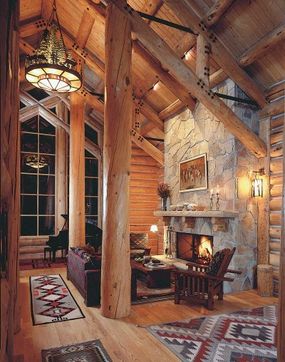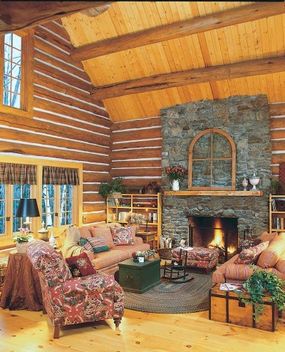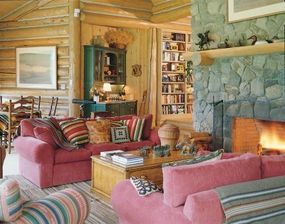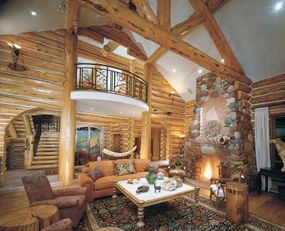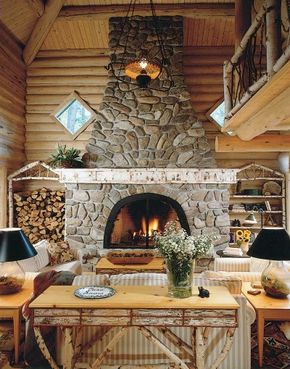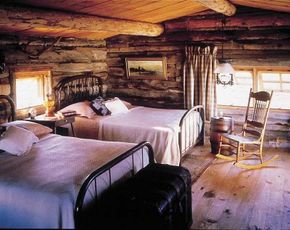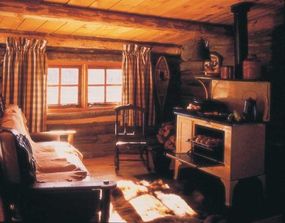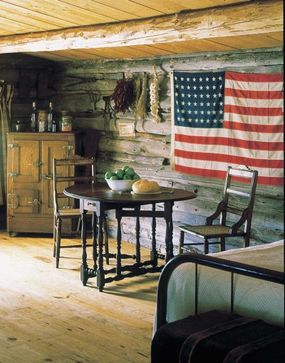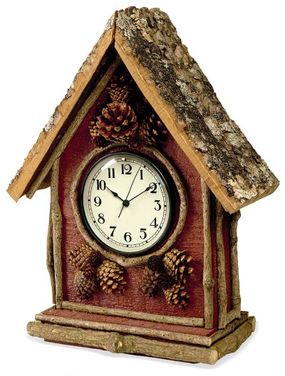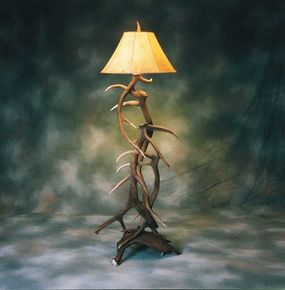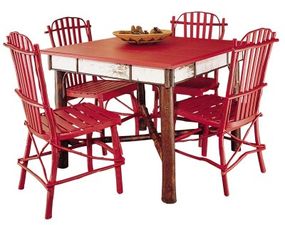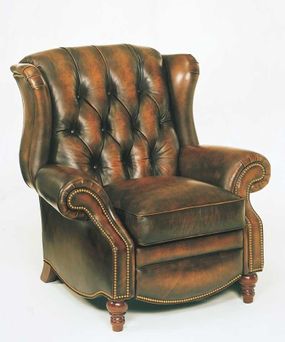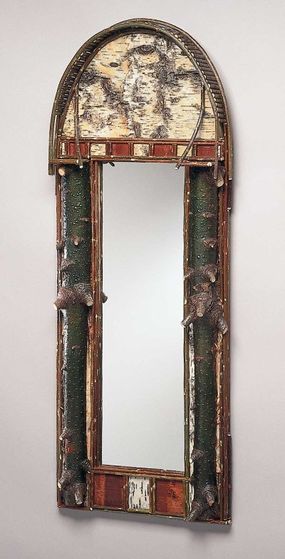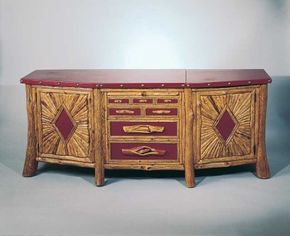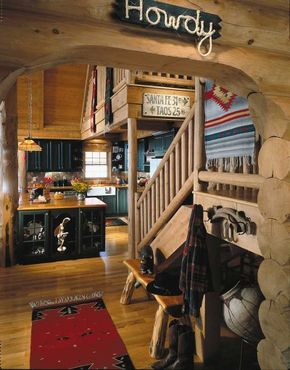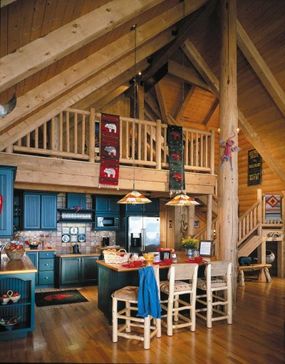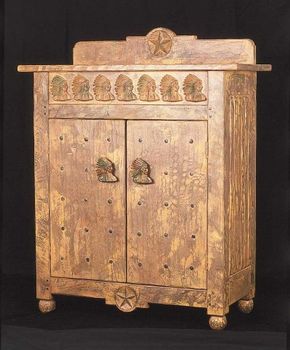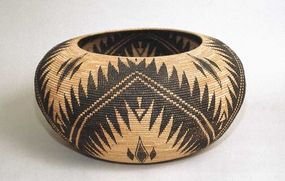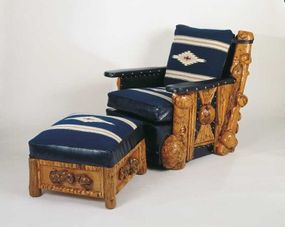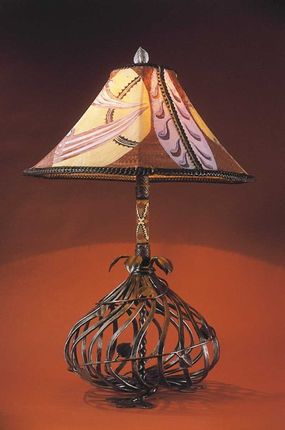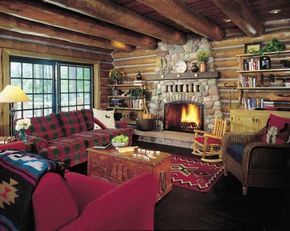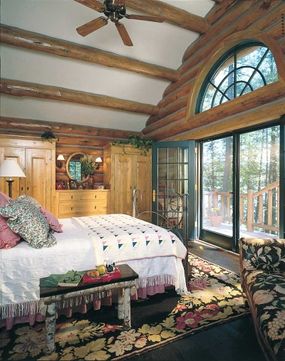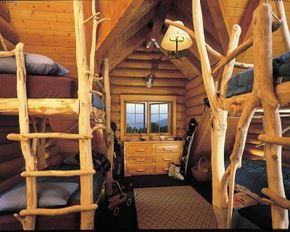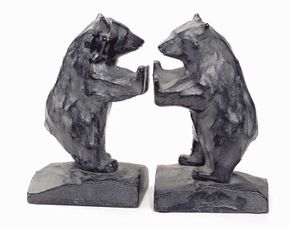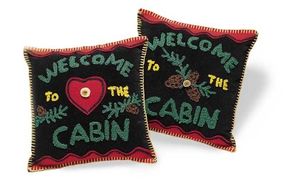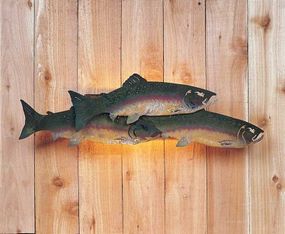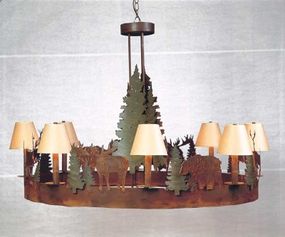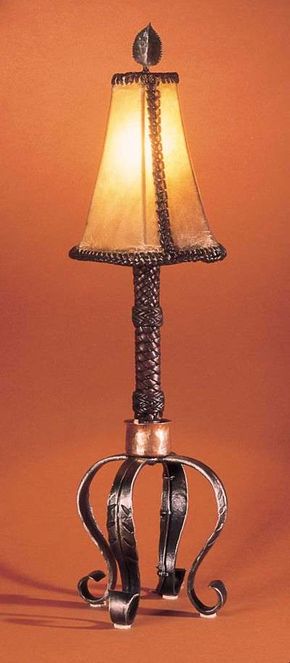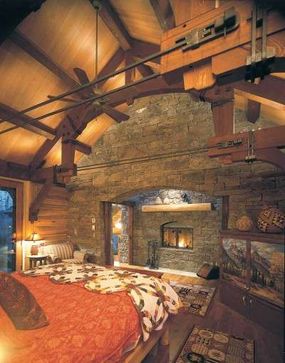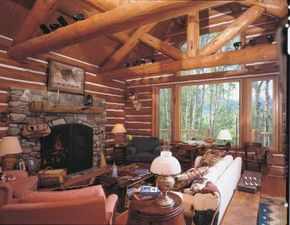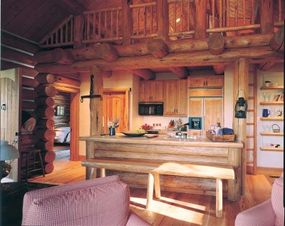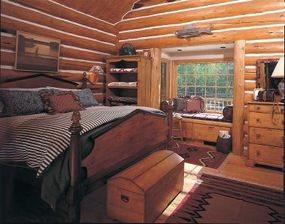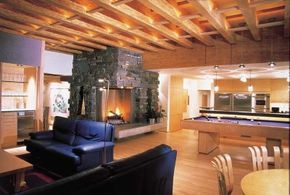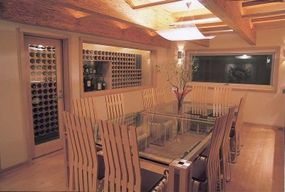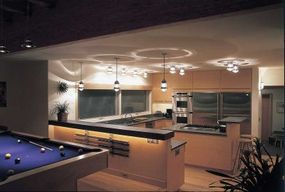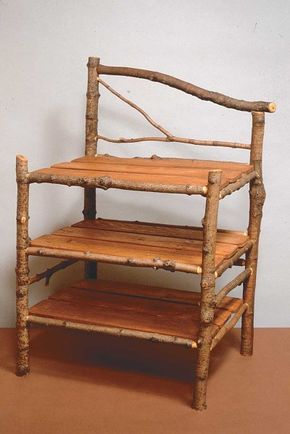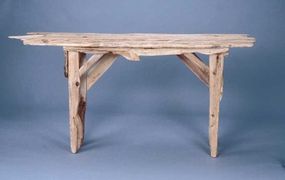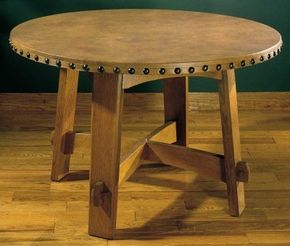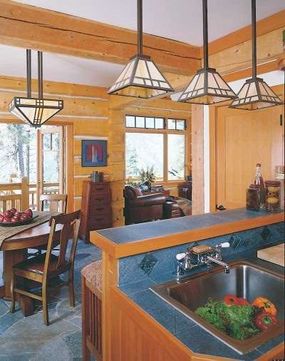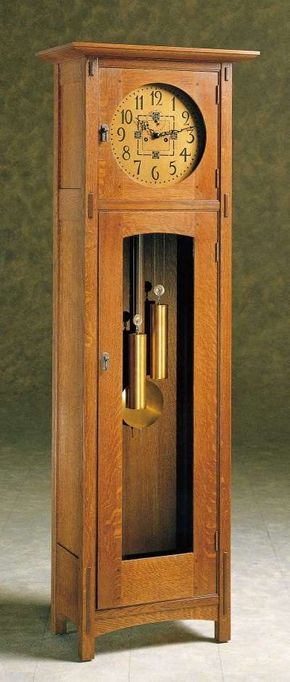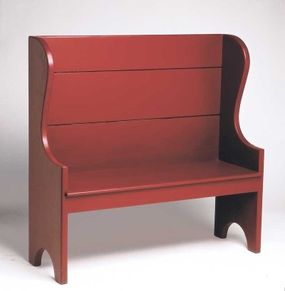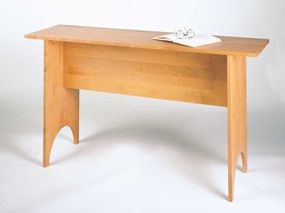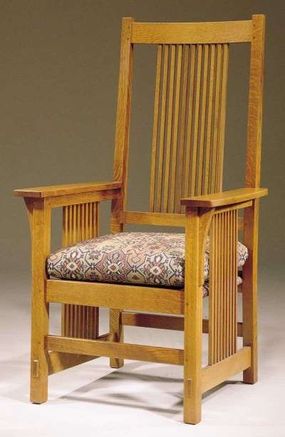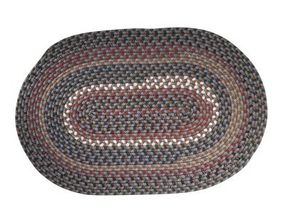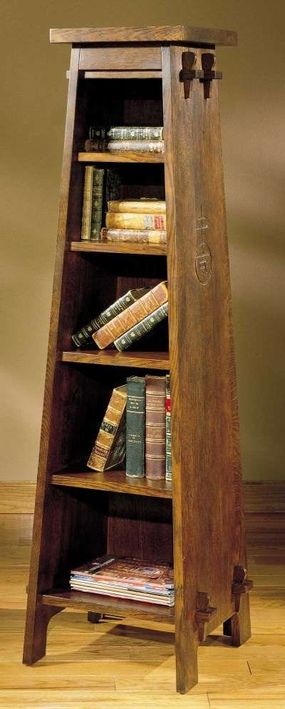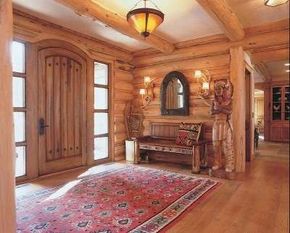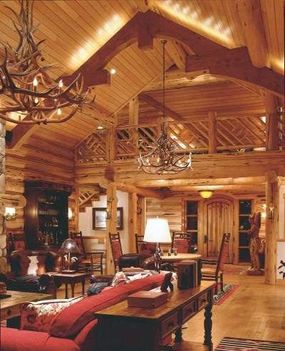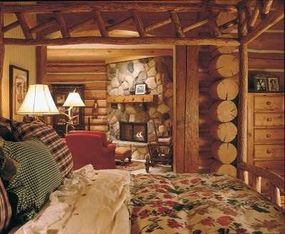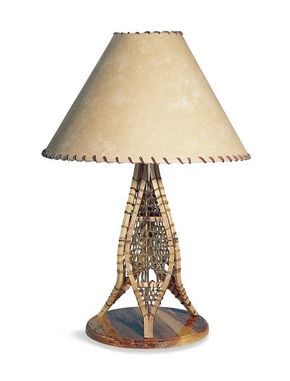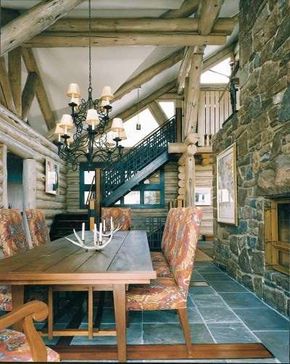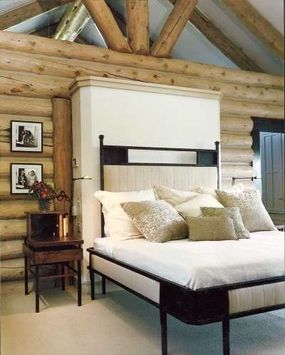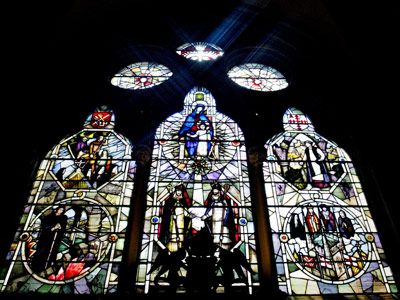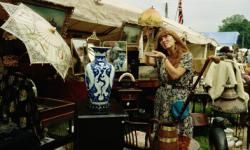Whatever your cabin decor taste, the log or timber frame home is at its heart a comfortable place that glories in the warmth of wood. Look up and you'll see beams and rafters, like the branches of a tree, supporting the roof. The sweet scent and quiet of the forest will embrace you as you walk through the door. Log cabin style is welcoming, honest, and unassuming.
In the Beginning
For centuries, people living in the forested regions of Europe and Scandinavia counted on trees for shelter. Their log-building and woodworking skills date back to medieval times. Although the people who fled Europe for the New World left much behind, they did bring along their skills at log crafting.
Residents of countries that had fewer trees, like England, built timbered homes. Instead of creating walls of solid wood, they used their sparse trees more sparingly for the walls' structure and completed the walls with infill made of a plasterlike material. Those who sailed from the British Isles and landed in New England built timber frame homes.
Today, we still celebrate these English, European, and Scandinavian ancestors with homes in Early American and Appalachian styles. For many people, Early American Windsor chairs and pewter candlesticks will never go out of style.
Far from the cluttered country look that engulfed the United States in the 1980s, the aesthetic of Early American is spare and dependent on pieces that typify fine woodworking. Colonists would have brought some of these cherished pieces with them on their journeys to the New World.
The shape of the house itself underlines Early American style. These homes have simple forms that include the symmetrical Colonial home, the classic Cape Cod house, and the saltbox. Inside an Early American home, a framed portrait may look down on a four-poster bed topped by a woven coverlet. The home's formal room may feature a gilded Federal-style mirror to reflect the light of a fire crackling in an open hearth.
The colors of these rooms can be cool, like Colonial blue, or warm, like oxblood red. And while the New England settlers preferred timber framing to logs for their homes, squared, Appalachian-style logs with wide bands of chinking look just right with this style.
South of New England in Appalachia, settlers built homes of squared logs. They also built furniture and wove textiles. The Appalachian-style log cabin embodies American country. Here you'll find rocking chairs on shed-roofed porches, wooden beds layered with scrap quilts, and open stone hearths filled with cast-iron kettles for cooking.
The shape of the Appalachian home was also simple. Often porches were tucked under the eaves of a gable roof, and a breezeway, known as a "dogtrot," connected two smaller square log buildings and offered a shady spot.
In these Appalachian cabins, kerosene lamplight spilled out onto families who made everything for themselves, from food to rugs to pottery to music. Their hands left behind their spirit, a lure for today's collector. That can-do attitude carried the pioneers to the West, where another log style blossomed.
Hands to Work
Decades after the first Colonists settled in the Northeast, the Shakers, a religious sect that fled persecution in England, landed in New York state. As the religion gained converts, Shaker communities formed in New England, Kentucky, and Indiana.
As part of their communal life, Shakers crafted furniture, baskets, and other items for sale. Although the Shakers' buildings were not made of logs, the style they created is well-suited for a home made of clean-lined logs or timber framing.
To remove clutter from living spaces, the Shakers perfected the craft of cabinetry. Wooden pegs on walls provided a perch for the assorted items that even simple life requires, like chairs, hats, and tools. The Shakers stripped away unnecessary ornamentation in their quest to create items that fulfilled specific purposes. Their furniture, while not overly carved or turned, gains its beauty from simple form, color, and the beauty of wood grain.
Because the Shakers believed in celibacy, their numbers have diminished to just a handful today, increasing the scarcity and value of their work. Reproductions enable all who enjoy clean lines and simple beauty to bring the Shaker look home. Ladder-back chairs and rockers, trestle tables, and tall chests of drawers exude Shaker style. Bandboxes and woven baskets are the perfect accessories. The Shakers also used color -- typically red, blue, and chrome yellow -- in their meetinghouses, homes, and furnishings.
More Is More
In stark contrast to Shaker style, Americans at the end of the 1800s loved opulence. The mass-produced furnishings and accessories manufactured during the Industrial Revolution fed their hunger. Ornate furniture topped with layers of silk and velvet and accessorized with bric-a-brac became the fashion. Oriental rugs decorated the floors, and heavy drapery dripping with fringe festooned tall windows.
By the end of the century in settled regions of the United States, log homes were out of fashion. New methods of framing homes with sawn, dimensional lumber and the invention of mass-produced nails meant that most people built wood-framed homes trimmed with decorative woodwork.
In fact, some people living in log homes at the time sheathed their outdated log walls in clapboard and paneling. Still, the Victorian look can successfully be brought to a log cabin, especially one with squared logs that offer a smooth canvas for hanging the multitude of paintings, mirrors, and knickknacks that are the hallmarks of this style.
For their abundant luxury, Victorian-style dining rooms and bedrooms are always in fashion, no matter what the architectural backdrop. Chandeliers that illuminate a dining table draped in heavy damask or lace and set with china, silver, and crystal elevate meals to special events. In the bedroom, the femininity of Victorian style makes for sweet dreams.
Back to the Hand
Not everyone loved Victorian style, however. Some found the ornate, garish, and machine-made goods shoddy. These people longed for a return to the Middle Ages, when fine artisans learned their crafts through a guild system. Thus, in the early 1900s, the Arts & Crafts movement was born.
Gustav Stickley, a furniture maker from New York state, personified the movement. To set the stage for his honest, handcrafted furniture, Stickley advocated a "sturdy and friendly type of architecture." In 1908, Stickley built a log farmhouse on 600 acres in rural New Jersey and dubbed it Craftsman Farms.
Inside a typical Arts & Crafts-style home, dark wood prevailed. Carved wainscoting stretched from the floor to eye level, and diamond panes or rectilinear designs ornamented windows and doors. Near the center of the home, an inglenook surrounded the fireplace, which may have been accented by handmade tiles. Richly grained wood floors were topped with rugs patterned after William Morris's textiles.
The furnishings produced at the time differed sharply from their Victorian predecessors. The linear style of Stickley's chairs and settees shrugged off the baroque ornamentation the Victorians loved. Like the Shakers, the craftspeople of this age relied on the wood's own beauty and the skill of their hands to make furniture both beautiful and comfortable.
Everything for the home was to be handmade. Light fixtures were made of copper and topped with mica shades. Pottery was thrown by hand. Woven curtains, table runners, and bed linens wore simple embellishments of stylized leaves and flowers. The colors were muted and natural.
Authentic and reproduction Arts & Crafts furniture and accessories look right at home with logs. Like log crafting, they echo the work of the hand, and their colors are the colors of the forest, suiting them perfectly for log and timber rooms.
Wealth in the Wilderness
At the height of the Victorian age, before the Arts & Crafts movement blossomed, the barons of the Industrial Revolution discovered the outdoors. Tales of abundant fish and game and the curing power of fresh air lured America's wealthiest families to the Adirondack forests of northern New York. There they bought up acres of land and planned for compounds of self-sufficient getaways.
Many of the compounds began as sites for permanent tents, but they quickly outgrew their rough origins. The goal was to make the wilderness luxurious, while maintaining a patina of rusticity. Small log buildings soon clustered around a main lodge.
Mother Nature served as interior designer: Birch bark lined walls and ceilings, twigs set in mosaic patterns trimmed windows and doors, crooked branches became stair railings, and stone piled up into foundations and chimneys. The lodges built in this style became known as the Great Camps.
Despite their remote locations, the owners of the Great Camps prided themselves on offering their guests every amenity, from electricity and indoor plumbing to bowling alleys and chapels. The furnishings of the camps reflected the period when they were built. Early log camps were furnished in ornate Victorian style.
As the century turned, however, Great Camp style veered toward Arts & Crafts, with Stickley-style rockers pulled up to stone fireplaces. No matter what the style, the evidence of the artisan's hand was everywhere. Beds were fashioned from hand-peeled and waxed branches, and handwoven baskets formed lampshades. Local craftspeople forged ironwork for the camps' light fixtures, hardware, and fireplace screens.
Spreading the Wealth
For decades, the Great Camps spread their influence across the United States. Their impact, and visions of Old World hunting lodges, has evolved into the lodge style that many of today's log cabin owners bring to their homes. Logs used in this style can be round or flat, or timber framing can be used. Whatever shape the wood takes and the bigger the logs or timbers, the better a backdrop for this truly masculine style of decor.
No lodge-style home is complete without a massive fireplace, preferably built of stone. Wood accents in the home's furnishings, floor, and trim may be dark and heavy. Picture a billiard room or library designed for gentlemen smoking cigars and talking politics.
The colors of this style are dark and muted tones of the natural colors that decorated the Great Camps: moss green, deep reds, and nutmeg browns. The deep colors also offer a range of textures, from leather to brocade to velvet. Antler chandeliers light these rooms with style. Of course, with a nod to the hunting tradition on which the style is based, animal mounts and trophies are a must.
Westward Expansion
Log cabins sheltered the pioneers as they settled the frontier. A man could build a log cabin with his own two hands. Inside, his wife would make the place a home with quilts, rag rugs, and maybe one or two good pieces of furniture that made the trip from back East.
Some pioneers abandoned their log cabins as soon as they had the wherewithal to build a frame house. Others, like the ranchers of the West, built their log homes for the generations.
Care was taken with log ranch houses to peel the logs and perhaps shape them to interlock with each other. If round logs were stacked up, the gaps between them were filled with chinking of horsehair and mud or plaster. A wide porch gave the ranchers room to wash up before they came inside.
Today, ranch-style log cabins endure as American icons. With a stone fireplace or an iron woodstove at its center, the cabin on the ranch is casual and utilitarian. Navajo rugs or cowhides might gussy up the wide-planked wood floors. The furnishings are oversized and comfortable, with a rocking chair stationed at the hearth and leather armchairs and sofas nearby for relaxing after a day of riding the range.
Log beds covered with woolen Native American blankets provide rest for the weary. Above it all hang chandeliers made of entwined antlers or forged iron. Saddles, boots, lariats, and spurs hung on the wall remind modern-day ranchers of their roots -- a lifestyle captured in Remington's bronze sculptures, which also look right at home in the log cabin ranch.
On the Light Side
Just as the wealthy Eastern establishment flocked to the Adirondacks at the turn of the century, a few decades later they began looking for outdoor adventure farther afield. To cater to these elite with visions of cattle drives and buffalo hunts, the dude ranch gained rapid popularity in the early 1900s.
Many dude ranches were spruced up for their city slicker patrons. The person who created what is termed Cowboy High Style was Thomas Molesworth, a furniture maker from Cody, Wyoming, who accepted several commissions to furnish Western ranches and hotels. His furnishings depict the Western lifestyle in romanticized glory. He peeled and polished fir and lodgepole pine branches to frame his furniture and upholstered the pieces in brightly colored leather or Chimayo weavings.
Wood burls and brass tacks were used as accents, and silhouettes of lone cowboys or Indian braves often decorated seat backs and headboards. Molesworth also fashioned special furnishings like bars and writing desks at which the dudes could pen postcards to send home.
Lighting for the dude ranch buildings came from iron or wagon wheel fixtures. The ranch's textiles followed tradition with brightly striped Hudson's Bay blankets and Navajo rugs. The accessories used to complete the setting included spurs, saddles, boots, and bows and arrows, while art on the walls depicted the fabled life of the cowboy singing under the stars and driving cattle across the great open spaces.
The furnishings, which followed the Arts & Crafts tradition, made the dude ranches comfortable for their posh guests, while still providing a somewhat primitive, rustic feel. Today, authentic Molesworth furnishings are highly coveted, and several Western companies craft reproductions for those who'd like to bring Cowboy High Style home.
The Cowboys and Indians theme can even be carried to its kitschy extreme with framed Western movie posters and pony-skin bar stools with cowboy boots for legs. Whether it's campy or sincere, your collection of Western memorabilia will fit right in to a log cabin of any style.
South and West
The desert Southwest offered its inhabitants few trees. There, precious timbers were used to create roof and ceiling structures to support the heavy roofs of adobe homes. Today, logs can be imported to these desert regions, and rounded, light-colored logs make a beautiful setting for decor inspired by the Southwest.
Southwestern style is a mixture of Spanish and Native American influences. Traditionally, small windows, thick adobe walls, and tiled floors helped keep homes cool in the desert heat. Today, terra cotta tiles and adobe accents make a wonderful, earthy complement to the warm wood tones of logs.
Southwestern-style furnishings may be carved Spanish Colonial wood tables and case pieces that remind us of centuries-old missions. The cruciform is repeated in carvings, recalling the influence of the missionaries. Some of these pieces wear a coat of paint in the colors of the sand, sunset, and sky.
On the floor or walls, brightly colored woven rugs and serapes add dashes of color. Beehive-style fireplaces take the chill off desert nights, and handmade pottery reflects the talent of native-born peoples. Mexican silver adds sparkle, while adobe is sculpted into soft, rounded archways.
Summer Places
Log cabins and summer vacations go together. In recreation areas across the country, from the woods of New England and the Northeast to the lakes of the Midwest, families built log cabins as escapes from their urban and suburban homes. The log style of these cottages and cabins varies from round to square, but it typically forms small, utilitarian buildings.
The basics of cottage style are comfort and practicality. Inside you'll find wood floors, sometimes painted a cottage gray. Walk through a screen door, and you step out onto a porch -- a must for enjoying summer twilights. In the kitchen, you'll find painted cabinetry or just open shelves stacked with Grandma's everyday dishes.
The furnishings of cottage style are unpretentious and include slipcovered armchairs, well-loved wicker, or a set of simple painted chairs gathered around a large pine table. Lighting comes from humble fixtures of tin or metal, and vintage table lamps cast a soft light on this nostalgic style. Chenille spreads and scrap quilts top off the beds, while faded chintz florals and awning-striped cushions add even more comfort.
Signs of the outdoors are at home here, too. Wildflowers in a Fiestaware vase or watercolors of lakeside views remind the owners of nature's beauty just outside the door.
Take cottage style, subtract its feminine wiles, and you have the look of the summer camp. These manly retreats, built to house hunters, fishermen, and summer campers, are more rustic than their cottage counterparts. Here, rounded log walls give a rustic background for simple, utilitarian furnishings. Tools of the trade -- guidebooks, maps, fishing poles and lures, rifles and mounts -- work as accessories.
Light may come from kerosene lamps or an antler chandelier, and a black iron woodstove dries wet clothes and crackles as fish stories are swapped. The kitchen is the place to clean fish and make strong coffee. It may be outfitted with vintage utensils like graniteware kettles and cast-iron skillets for frying up the day's catch.
The Contemporary Cabin
While many log cabin styles glory in the patina of age, modern and contemporary decorating schemes fit right in to log cabins, too. Lovers of the clean, sparse lines of contemporary looks may choose a light-colored log or timber frame to enhance the style. Wide windows with no divisions carry out the modern look and open the cabin to the outdoors. The furnishings may be inspired by Scandinavian blond wood and chrome classics.
The contemporary home takes on an open floor plan. Sleek touches add their edge, from metal spiral staircases and railings to glass block. A fireplace is still the center of the home, but instead of being rustic and ornate, it's stripped to its essence of firebox and hearth.
Lighting can also add contemporary flair. Recessed lights, track lighting, and tapered torchères add drama to the space as they spotlight log trusses and ceiling beams. In the kitchen, stainless-steel appliances reinforce contemporary style. The primary colors of a Mondrian painting or a wash of neutrals all carry the look, and accessories are carefully edited.
All Together Now
Of course the log cabin's easy attitude accepts a mixture of styles. If your taste tends toward the eclectic, you'll find logs accommodating. No-fuss country style combined with Shaker simplicity and contemporary precision leads to homes that follow no set rules; instead, they cater to their owners' wide-ranging interests. The casual eclectic style works in any wood home, regardless of the style of timbers or log work.
In the next section, go "back to the land," and learn how to decorate your cabin to reflect a changing frontier landscape.
For more decorating ideas, see:
